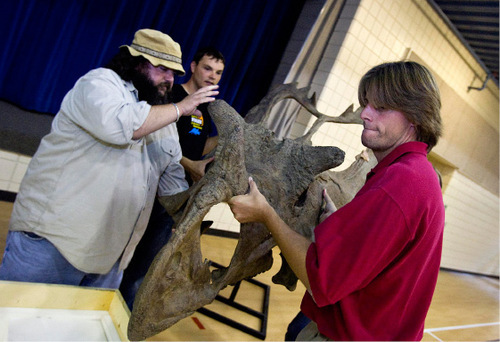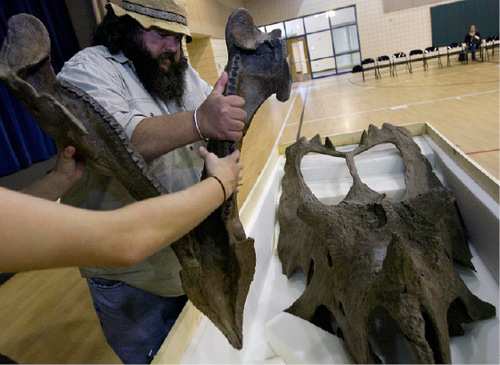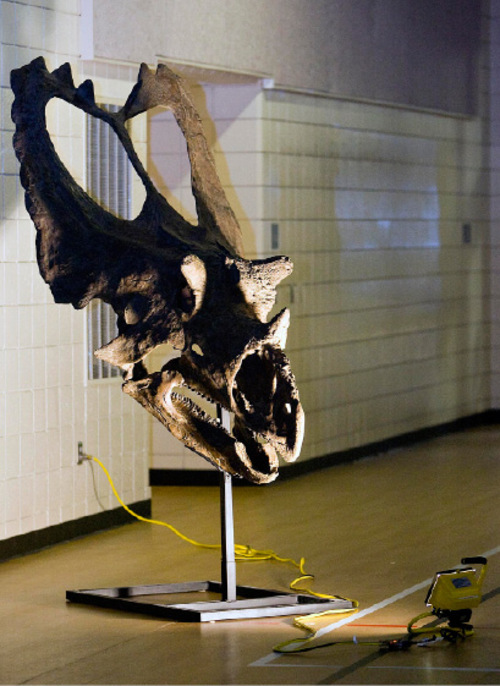This is an archived article that was published on sltrib.com in 2010, and information in the article may be outdated. It is provided only for personal research purposes and may not be reprinted.
"Weird" and "wonderful" were words used to describe two massive horned dinosaur skulls shown to the world for the first time Wednesday at the Utah Museum of Natural History.
Utahceratops gettyi and Kosmoceratops richardsoni roamed what is today the Grand Staircase-Escalante National Monument in southern Utah 75 million years ago during the Late Cretaceous period when the continent was split in two by an ocean.
The findings of the team that discovered and classified the creatures were published Wednesday in the online scientific journal PLoS ONE, said Scott Sampson, paleontologist research curator for the museum.
The Utahceratops skull is seven feet long with horns that grow sideways out of the skull like a bison's. The Kosmoceratops has 15 horns, some also growing sideways, along with 10 bones spiking from the top of the fan-shaped shield growing out from the back of its head.
The two skulls are unique in their horn arrangements and evolved differently from other dinosaurs in the Triceratops group that once roamed from Alaska to Mexico.
Previously, scientists thought that particular species of dinosaurs in groups like Triceratops lived at different times. But the discovery of the two skulls suggests different species lived at the same time.
Scott Richardson, an amateur paleontologist and seasonal worker for the Monument, who discovered Kosmoceratops in 2006, said he was exploring an area of the Kaiparowits Plateau when he found a baseball-size piece of bone.
He said while looking for the origin of the bone, he planted his geology hammer into a hillside.
"Lo and behold, a bone came out," he said.
He took the specimen to Mike Getty, paleontology collections manager at the Museum of Natural History, who examined the bone.
"The next day [Getty] came into town and I asked him about the bone," said Richardson. "He said it was nothing, but a big grin came across his face and said it was an incredible find."
Having your name attached to that of a new dinosaur species is a rare privilege not missed by Richardson.
"It's awesome," he said.
Getty said Utahceratops is the first species bearing his name and the second species of dinosaur besides Utahraptor to bear the state's name.
Getty first found evidence of Utahceratops in 2000 when he found an unusual piece of bone while exploring part of the rugged Kaiparowits Formation.
"We knew we had something new," said Getty.
It took almost a decade for Getty and other paleontologists to piece together the huge skull from fragments of the species found in an area spread over 30 square kilometers.
"It was like putting together a puzzle," said Getty.
The discoveries are just the latest of 16 new species that have been discovered in the bone-rich monument in the past 11 years.
"There's more to come after this," said Sampson, who described the monument as a wild, remote and rugged place of few roads.
"Its [exploration] is a logistical challenge," said Sampson.
Also Wednesday, the dinosaur skulls were taken to Daybreak Elementary School in South Jordan to introduce students to the wonders of paleontology. Some may have already learned about a number of those wonders from the PBS television show "Dinosaur Train," hosted by Sampson, who is often received as a rock star by children.
The public will have a chance to see the pair of skulls Thursday from 4 p.m. to 8 p.m at the Museum of Natural History, 1390 E. Presidents Circle, at the University of Utah.









